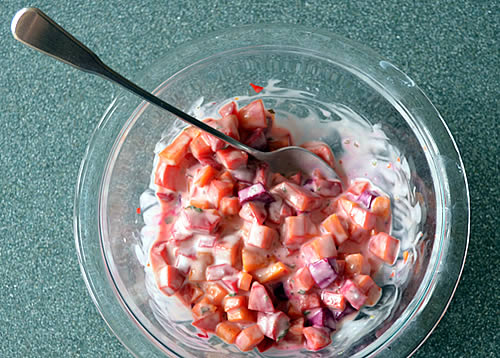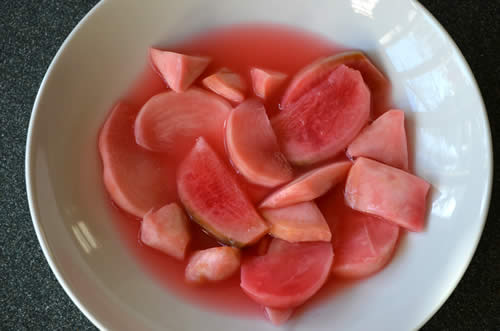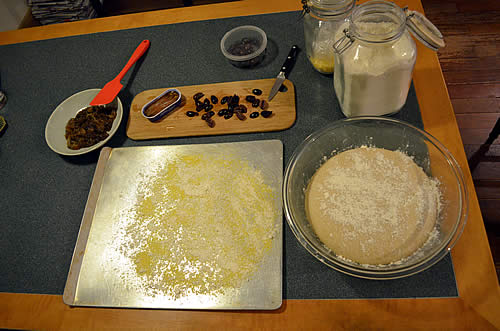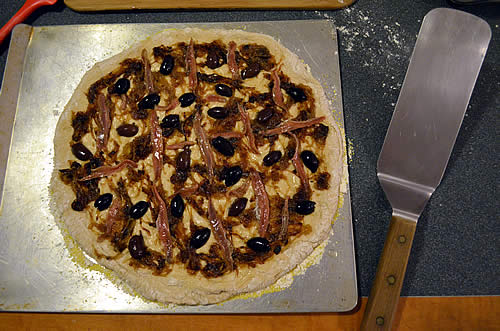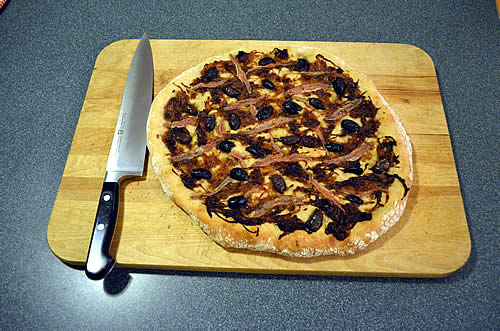 About Kohlrabi
About Kohlrabi
 Kohlrabi is in the Brassica oleracea category. The part that is eaten is the stem, which swells into a globe, rather than the root. It can grow to the size of a grapefruit, but will tend to have a wooly interior, so it is far better harvested at half the size.
Kohlrabi is in the Brassica oleracea category. The part that is eaten is the stem, which swells into a globe, rather than the root. It can grow to the size of a grapefruit, but will tend to have a wooly interior, so it is far better harvested at half the size.
There are two varieties, green and purple, but both taste similar. They have a distinctive flavor, something of fresh water chestnuts with a touch of radish and celeriac. They make a marvelous foil for other flavors; sometimes fooling people into thinking they are artichoke hearts. Kohlrabi is rich in potassium, fiber, and vitamin C.
It is particularly good as a salad or in a platter of crudités when par-boiled. Slice it and simply simmer it for a few minutes, then leave in cold water for a while before draining and mixing with other vegetables.
Grated it can be lightly cooked, stir-fried in a little oil or butter with some mustard seeds to give it some spice. You can stuff it, or use it instead of potatoes in gratin dishes. It can also be used like cauliflower.
Kohlrabi Salad
Kohlrabi Gratin
Cream of Kohlrabi Soup
Sauteed Kohlrabi
Farmer Tom’s Mashed Kohlrabi
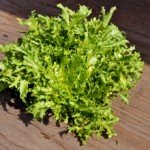 The Chicory Family
The Chicory Family

Frisee
Much more appreciated in Europe than in the United States, the chicory family is a large one. Belgian endive, curly endive (sometimes called frisee), escarole, and radicchio are all members. Each differs considerably in appearance, color, and to some extent flavor, although all share a slightly bitter taste, and most produce a root that can be roasted, ground, and combined with coffee to create the chicory coffee beloved in French/Creole cultures.
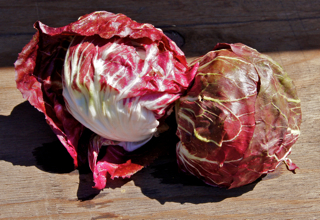
Radicchio
The chicory family is a wide and varied group that can be loose-leafed or tightly-headed, tapered or round, smooth-leaved or frilled. They are also brightly colored, ranging from the purest white and pale yellow to bright green or maroon.
All members of the chicory family are flavored for the bitterness that they all share, unlike lettuces, which are chosen for their delicacy. The chicories’ bite and texture combine nicely with richer ingredients in salads, like fruits, nuts, and sharp cheeses or smoked salmon, chicken or ham.

Escarole looks a bit like Romaine Lettuce.
Try chicories with the following additions: Fresh shell beans or fava beans, blanch until tender. Remember that adding vinegar or lemon juice will cut the bitterness of the choicories.
Braised Escarole with Garlic and Lemon
Apple Escarole Salad with Blue Cheese and Hazelnuts
Sauteed Escarole with White Bean Salad
Warm Salad with Frisee and Glazed Squash
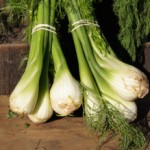 About Fennel
About Fennel
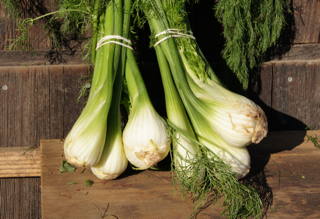 A bulb of fennel looks like a bunch of celery with a wide, round base. It is a member of the parsley family and is prized for its mild, licorice flavor. The individual stalks are beautifully plaited, and broad and thin, while the tops are round and fleshy. Fennel leaves are ferny and also have a licorice flavor. All parts are edible. The stalks and bulb can be used raw, chopped in to salads, or cooked. Sautéing in butter with a simple fresh herb highlights its pleasant taste, and steamed fennel with a cream sauce is also excellent. English cooks in centuries past made a cod fennel soup with the sliced stalks, some wine, sugar, ginger, and almonds. The leaves are an herb that can also be chopped and used as a garnish.
A bulb of fennel looks like a bunch of celery with a wide, round base. It is a member of the parsley family and is prized for its mild, licorice flavor. The individual stalks are beautifully plaited, and broad and thin, while the tops are round and fleshy. Fennel leaves are ferny and also have a licorice flavor. All parts are edible. The stalks and bulb can be used raw, chopped in to salads, or cooked. Sautéing in butter with a simple fresh herb highlights its pleasant taste, and steamed fennel with a cream sauce is also excellent. English cooks in centuries past made a cod fennel soup with the sliced stalks, some wine, sugar, ginger, and almonds. The leaves are an herb that can also be chopped and used as a garnish.
Among herbalists, fennel is viewed in several ways: as an intestinal antispasmodic, for relieving intestinal spasms or cramps; as a carminative, for relieving or expelling gas; or as a stomachic, for toning and strengthening the stomach; and as a anodyne, for relieving pain.
To prepare, separate the stalks, cut off the base where they are connected then pull the stalks apart gently. To cut the bulb into wedges, trim the base no more than necessary then carefully quarter the bulb lengthwise. If left exposed to the air for a very long time, the flesh can discolor. Either rub cut parts with lemon or place in a bowl of water splashed with vinegar for no longer than 30 minutes.
The feathery leaves make a nice garnish or can be chopped and used as an herb. The top round stalks can be used for a stock seasoning. Fennel is delightful raw, dipped in light sauces, and a lovely addition to salads. It is best roasted, braised, grilled, or sautéed. Or it can simply be simmered in a seasoned stock. Fennel is wonderful with fish, tomatoes, oranges, apples, walnuts, cheeses, lemon, and dill. Allow about ½ bulb per serving.
Endive or Lettuce Boats Stuffed with Fennel, Apples, and Walnuts
Spinach, Arugula, and Fennel SaladCarrot and Fennel Soup
Fennel Frittata
 About our Strawberries
About our Strawberries
We plant over 80,000 strawberry starts every year in our fields, growing two to three varieties: Albion, Chandler, Seascape. This mix of early- to late-bearers provides us with consistent flavor and harvests throughout the fruiting season in our area, which usually begins in mid-April and runs through October (some years even into November).

We do our best to ripen the berries in the field as much as possible, and the weather conditions they experience in the last couple days before harvest make a huge difference in their store-ability. Early in the season, and with consistent cooler weather, they remain firm when ripe and can store well for up to a week. In summer heat, when nighttime temps remain high, and wetter conditions the berries can be far more fragile, and they’ll quickly become mushy and moldy if not enjoyed right away. At these times we highly recommend processing the berries in some way as soon as you get them home, if you haven’t already eaten them all on the way there ;-). If you are not going to use summer-ripe berries within the first day or two, consider freezing them for making a smoothie, cobbler, pie filling, or sauce at a later date.
Click here for a video of Farmer Tom talking about growing strawberries organically, or go here: https://www.youtube.com/watch?v=MKY-deJbKJI
(video produced by Veggie Box)
Here are some storage tips: do not wash the berries until you are ready to use them. When you get them home, remove the berries from the basket or clamshell, eating or discarding any that look really ripe or kind of sad. Place remaining berries in a single layer in a close-able container lined on the bottom with paper towels. Put the lid on the container and place in the fridge. Under ideal fridge conditions, the berries ought to keep a number of days this way.
While terrific just on their own, there are many ways to use strawberries. For instance, they can be sliced up to top off a piece of buttered toast with honey for breakfast, or sprinkled in a dinner salad to add a little sweetness.
Here are some other recipe suggestions that include them:
Agua Fresa with Strawberries
Strawberry-Rhubarb Compote with Ginger and Lime
Strawberry Sorbet
Strawberry Muffins
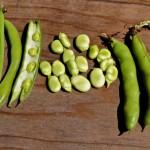 Fava Beans – Slow Food Moment
Fava Beans – Slow Food Moment
 When it comes to Fava Beans, patience has it’s rewards. I love these beans, only available in the Spring, they are a seasonal treat. Debbie Palmer (Live Earth Farm’s first CSA coordinator) developed a recipe database, still available to members – thank you Debbie 🙂 – chockfull with amazing recipes and cooking tips. Here is what she recommends on how to handle Favas:
When it comes to Fava Beans, patience has it’s rewards. I love these beans, only available in the Spring, they are a seasonal treat. Debbie Palmer (Live Earth Farm’s first CSA coordinator) developed a recipe database, still available to members – thank you Debbie 🙂 – chockfull with amazing recipes and cooking tips. Here is what she recommends on how to handle Favas:
When to eat fava pods whole, when to shell them, and when to skin the beans inside
Here’s my rule of thumb: while the pods are still nice and green and smooth, and the beans inside are relatively small, eat ‘em pod and all (see recipe ideas in database). Even if the beans inside are starting to looking big enough to eat on their own, if the pods are still in good shape I’m cool with eating the favas pods and all (but if you prefer to shell them, shell away; it’s up to you). Once the pods get big and kind of warty-looking (which they do!), I’d definitely shell ‘em.
In a similar vein, the question of whether to peel the beans inside is up to you (and maybe depends on how you’re going to use them). I skin ‘em or not kind of according to my mood. If they’re really big, I generally peel them, but if they’re small, I often don’t bother. If you’re going to be using them whole in a pasta dish or soup or something, it’s six one way half-dozen the other. If you’re going to be making a puree or spread though, you’ll want to skin them first. It’s a texture and a taste thing (as well as an appearance thing). Try it both ways and see what you like best! The skinned beans are a prettier bright green, versus the skin-still-on beans, which are a paler green.
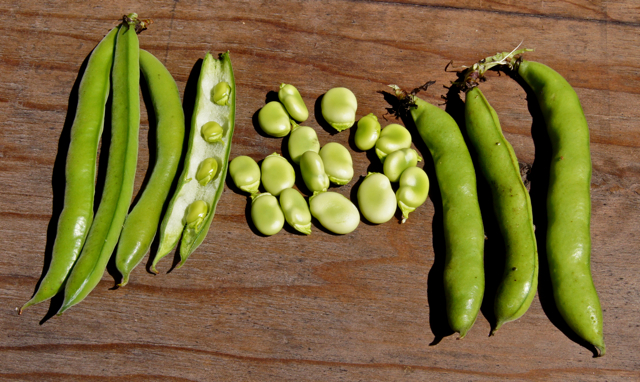
 Artichokes are a great source of dietary fiber, magnesium, the trace mineral chromium, vitamin C, folic acid, biotin, the trace mineral manganese, niacin, riboflavin, thiamin, vitamin A, and potassium. A medium-size artichoke delivers all these nutrients for a mere 60 fat-free calories, and also provides 4.2 grams of protein, no cholesterol, 0.2 grams of fat, and 11.32 grams of carbohydrate with 5.4 grams of fiber.
Artichokes are a great source of dietary fiber, magnesium, the trace mineral chromium, vitamin C, folic acid, biotin, the trace mineral manganese, niacin, riboflavin, thiamin, vitamin A, and potassium. A medium-size artichoke delivers all these nutrients for a mere 60 fat-free calories, and also provides 4.2 grams of protein, no cholesterol, 0.2 grams of fat, and 11.32 grams of carbohydrate with 5.4 grams of fiber.
Scientific research shows artichokes have a long history of treating many liver diseases. One of the active compounds, cynarin, is found in the leaves, and in the bracks and heart. Artichoke leaf extracts have demonstrated significant liver-protecting and re-generating effects. They promote the flow of bile and fat to and from the liver. This is important because if bile is not transported adequately to the gallbladder, the liver is at risk of damage.
Tips for preparing:
Rinse each artichoke under cold running water, or swish it vigorously in a large bowl of water. Once properly cleaned, with a sharp knife, cut the artichoke’s top-most inch to remove upper inedible leaf tips. Trim the remaining outer leaves with kitchen shears. To prevent cut parts from darkening, rub them with lemon juice or place entire choke in a bowl of cold water with lemon juice or vinegar added. Immediately before cooking, pull off any coarse leaves at the bottom, and cut the stem flush with the base.
Artichokes can be steamed, baked, or boiled and are delicious eaten warm or cold. Artichoke hearts can also be sautéed or stir-fried alone or with other vegetables in small amounts of broth or oil.
To steam artichokes, stand trimmed choke, stem end down, in a vegetable steamer and cook, covered, over boiling water. You can add garlic slices tucked between some of the leaves and drizzle with a little olive oil before you start steaming. The cooking time ranges depending on the size of the artichoke – 25-40 minutes or so. You can poke the heart to check for tenderness. If the chokes aren’t done you can always put them back and cook another 5 minutes, or until tender.
Follow the same procedure to boil, adding 1 tablespoon of lemon juice or vinegar to the water that completely covers the artichokes and is boiling. Cooking time is about the same.
Try an olive oil and balsamic vinaigrette for a dipping sauce, or an Asian flair with soy sauce, lemon juice, or rice vinegar, minced garlic, and grated fresh ginger, and a dash of dark toasted sesame oil. For a rich creamy dip, try whole Greek yogurt for the base – flavor with roasted red bell peppers; roasted eggplant, lemon juice and garlic; or a rich blue cheese-buttermilk-based dressing.
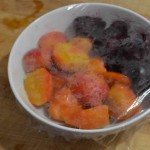 Any Day Beets
Any Day Beets
I read the most wonderful book recently entitled An Everlasting Meal by Tamar Adler. (Oodles of thanks go out to CSA member Cynthia Fan, who recommended it to me! I am forever grateful.) If you can find it at your local library, check it out — you won’t be sorry. That’s what I did, and I loved it so much I had to purchase myself a copy because I wanted to dog-ear pages and underline and circle stuff and write things like, “yes! exactly!!” in the margins. This book re-reminded me that preparing a meal is not a discrete enterprise, but rather that meals (that’s plural, with an “s”) are an evolutionary process that take place over time, where the end of one thing becomes the beginning of another, and what’s left from that can be transformed into yet another thing, and nothing need go to waste. Meals are a process, as well as a product.
With that in mind, I want to talk about beets. Simple, beautiful beets. Not beet recipes, but the Tamar-inspired process of handling them, preparing them, and then being comfortable with deploying them over the course of a week in various guises. I by no means exhaust all the things you can do with them here; all I want to demonstrate is that this is easy. I think sometimes people are daunted by beets, and they shouldn’t be. Once you get over the hump of cooking with a scary new vegetable for the first time, you’ll find fear is rapidly replaced by the easy confidence of experience, and then quickly wonder what all the fuss had been about in the first place.

Back to beets. They have different parts – roots, stems, leaves; you can eat all parts (the leaves are so very like chard), and of course Tamar encourages this (I do too) –however I include under the “nothing need go to waste” umbrella other beings in addition to ourselves. I.e. if you aren’t going to eat some part of the plant yourself, the leaves or stems, say, there are others – your chickens or rabbit or worm-bin worms… even the microbes in your compost pile – who will gladly make good use of them, hence they will not go to waste. Waste, to me, is when food goes into your garbage can, then into an anaerobic landfill where its nutrients are prevented from returning back into the earth. But I digress.
Beets, when separated from their stems/leaves, will keep many weeks in the cool of your refrigerator, however like most veggies they’re best when fresh. But if you don’t think you’re going to get to them this week, don’t dismay; just separate them from their stems/leaves, bag and refrigerate ’til you can get to them. This is helpful if you want a larger accumulation of them to prepare; you can combine beets from more than one week’s CSA share and cook them all at once. That’s what I did here. Well – truth time – we’ve been off from the CSA for a month, so these were beets I got from the farmers market — goldens one week, reds the next — but the process is the same no matter where you got them from.
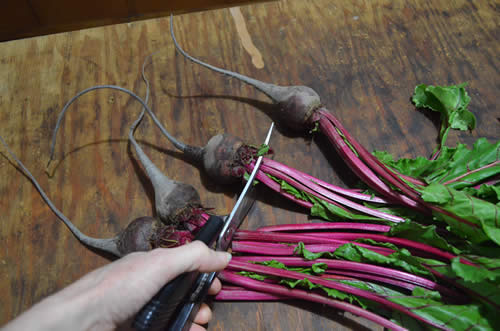
When I get my beets home, I always cut and store the roots and leaves separately. I’ve taken to using these EvertFresh produce bags as they seem to contribute to veggies’ freshness during storage, but you need to make sure the things you store in them are completely dry (The same logic applies even if you’re using a regular plastic bag; wet produce in a plastic bag rots pretty quickly). If I don’t have time to wash and lay out greens to air dry before storing, a quick-and-dirty that works great is to simply roll them up in a cotton floursack towel and stick them, towel and all, into the bag. The towel absorbs the moisture. Then a day or so later, remove the towel, which will have absorbed the moisture, and put the (now dry) greens back into the bag. Works like a charm. They’ll keep nice and fresh for a week or more this way.
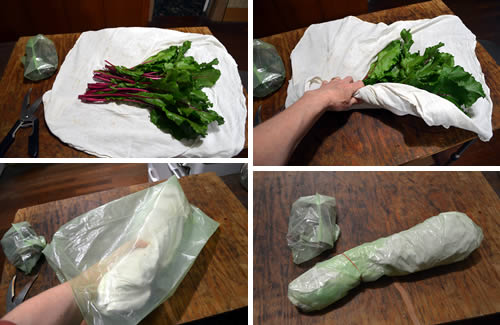
(Here they are the next day, fresh as a daisy, but no more moisture clinging. Took ’em out of the floursack towel and returned them to the bag.)
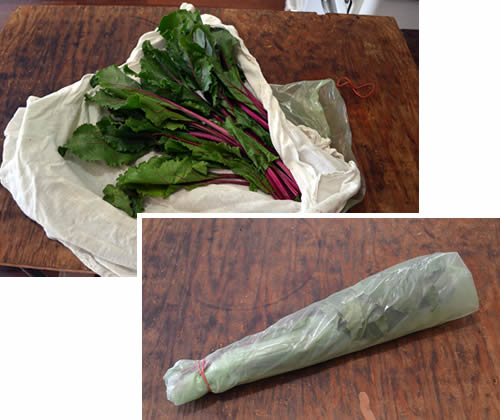
Okay. You’ve done your initial stabilization and storage; time to put your treasures into play!
The beets themselves – the short of it: rinse ’em, roast ’em, peel ’em, vinegar ’em. Do ’em all at once, so they’ll be at the ready for quick inclusion into meals over the week. Vinegar, you ask? Here’s a quote from An Everlasting Meal that stuck with me: “Vinegar seems to bring out the very essence of the beet. It doesn’t make theoretical sense that they’d taste more like themselves after being dressed with vinegar, but this is not theoretical.” You know what? Tamar’s right! I didn’t know that before, but sure enough, the vinegar just enhances the beets’ beety-ness. New wrinkle for the ol’ grey matter! I love that! Right; okay, on to the long of it.
Preheat your oven. 400 degrees.

Rinse ’em. Since the beets are going to get peeled, you don’t really need to scrub them, just give ’em a rinse in the dish you’re going to roast them in ’til the water runs clear (leaving some of the water in the bottom so they’ll steam while roasting). Tamar says to give ’em a drizzle of olive oil, and I’ve done it both with and without (without, ‘cuz I forgot), and haven’t noticed a difference in how they cook, so feel free to go either way.
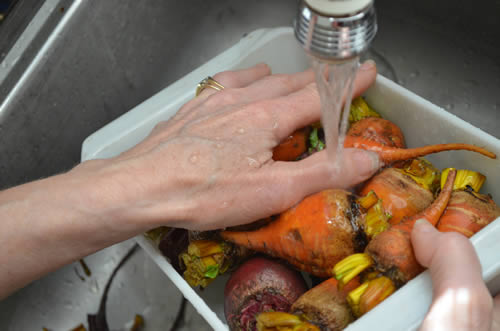
(leave a little water behind in the dish)
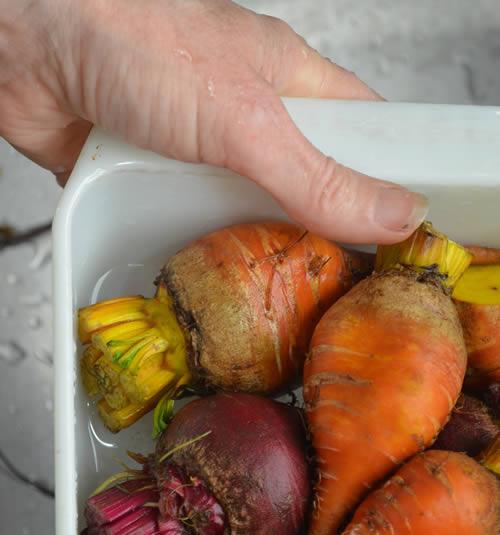
Roast ’em. Cover the beets before sticking in the oven. I have this old covered baking dish of my grandmother’s, but you can just use foil if you don’t have a covered dish. Actually, I don’t like aluminum foil being in direct contact with my food, so I follow Rebecca’s lead and put a sheet of parchment paper between the foil and veggies. Whichever way you go, seal it up good. Roast them for 40 minutes, then test them –

The tip of a sharp knife should meet no resistance when slipped into a done beet. As Tamar says, “If you’re not sure if they’re done, they’re not.” If you’re cooking beets of different sizes together, pull out the done ones, re-cover and continue to cook the others as needed. Actually if I have some beets that are big and some small, I just cut the big ones in half and tuck them in amongst the small whole ones. People say “don’t cut the beets or they’ll bleed” – and I ask you, have you ever had beets not bleed? Even if left whole? Sheesh. Cut them guilt free. They bleed no matter what.
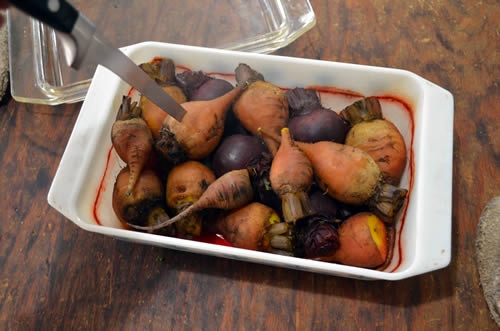
Peel ’em. This is the messy-fun part. When cool enough to handle (if impatience prevails such that I can’t wait for them to cool naturally, I’ve been known to stick ’em under a cold faucet), they’re easy to peel. Cut off the top, then get a grip on the peel and sorta squinch it towards the root end and it just slides right off. You can cut the root off before or after; doesn’t matter. Sometimes you’ll get a beet that doesn’t want to squinch nicely and so maybe you have to do a little rubbing with a thumb or scraping with a knife. (The goldens seemed more recalcitrant than the reds, but I don’t know if that was because they were older, or had more imperfections in their skins or what.) Yeah your fingers will get stained, but it washes off easily.
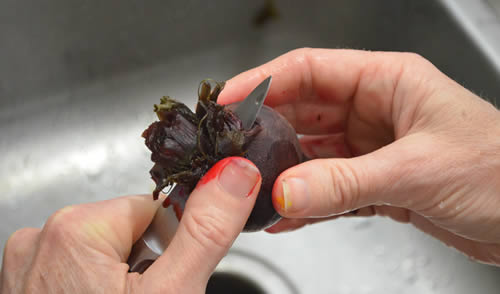
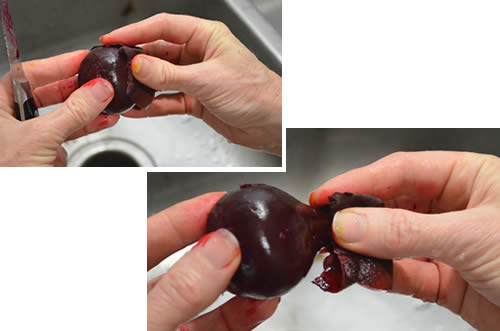
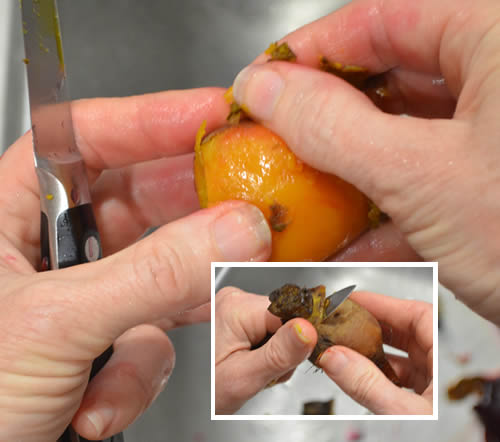
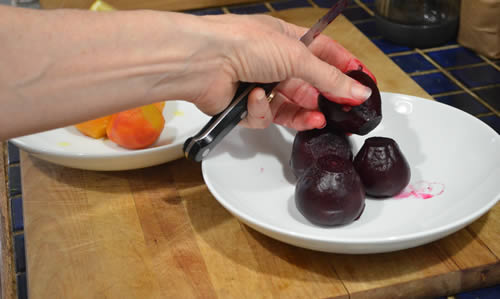
Vinegar ’em. Cut the beets; halves, slices, wedges… you just want to offer up surfaces for accepting the vinegar. If I have two different color beets like I do here, I’ll vinegar them separately, and use a lighter color vinegar (champagne, white wine, cider or rice) for the goldens, and a red wine vinegar for the reds, but you don’t have to do this. You can use the same vinegar for all and they’ll be just as good. Tamar says to salt ’em too, and I’m either-or on that front, seeing as how some vinegars have their own saltiness; taste one with just the vinegar, see what you think. If you think “salt” then add some.
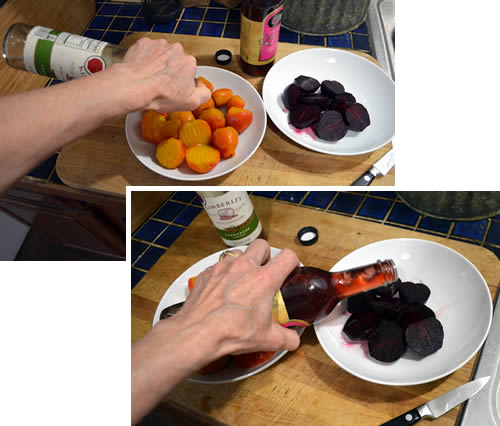
They are now in a good way, happy and ready to be eaten right now if you like (drizzle with a little olive oil and sprinkle with salt if you didn’t above), or put into the fridge for “instant” availability later. I put them all in the same bowl just so they’d take up less space in the fridge. They don’t mind being snuggled together. That’s what I did in this example, and then pulled them out on four different occasions, using a few each time ’til they were all gone about a week later…
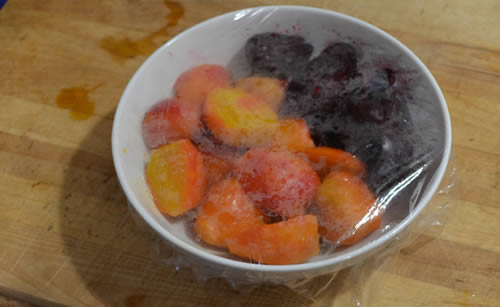
Occasion One. Served atop their sauteed tops. Chop the greens (the ones you so lovingly stored and bagged). Chop some garlic. Heat some olive oil in a skillet. Add said garlic, sizzle for a moment or two…
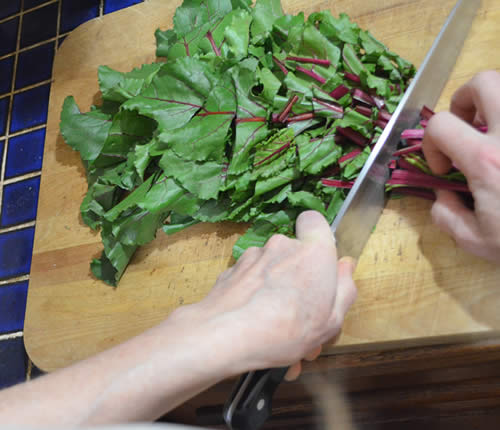
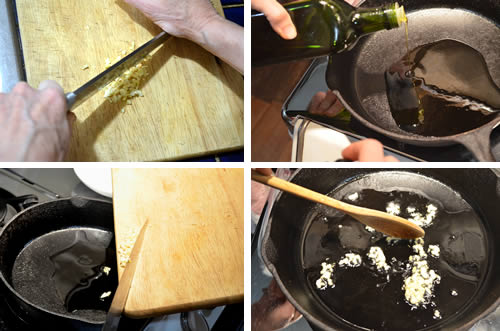
Add the chopped tops, a splash of water, a goodly sprinkle of salt. Give ’em a bit of a stir to see they’re starting to wilt, then cover and let steam until they’re tender to your liking.
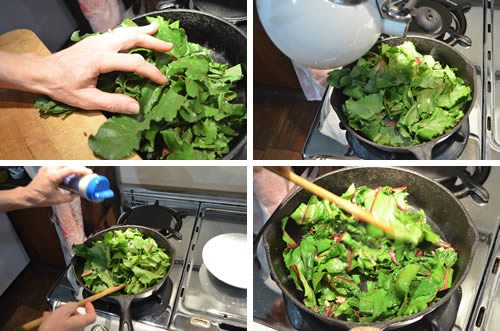
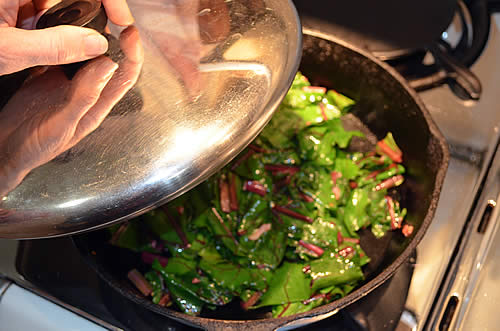
Put cooked greens on your plate, cut up some beets and put ’em on top (cold or room temperature is fine; you don’t need to reheat them); dress them all with more vinegar and some olive oil, maybe another sprinkling of salt. Crumble on some feta cheese if you like.

Occasion Two. Plain. Just cut ’em up (cold or room temp) and include them as a side with your meal. A little lemon or vinegar, a little olive oil and salt; the usual suspects. Or go ahead and heat them and then melt a little butter over them and sprinkle them with salt. Look at the beautiful color they add to the meal! A little pureed squash to one side, something green to the other… that’s just a little piece of pan-browned fish on the rice, but it could be anything. You get the idea.
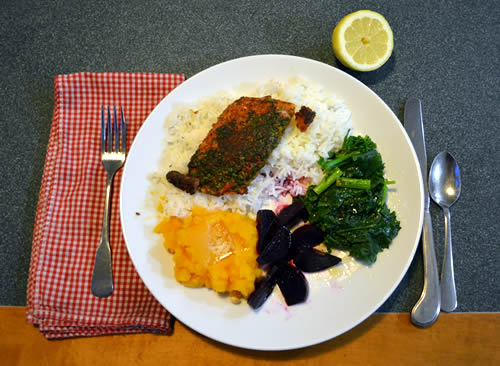
Occasion Three. Diced up into a tossed salad. No more explanation needed.
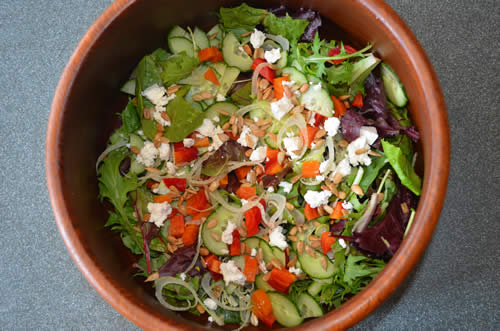
Occasion Four. Yogurt and Mint. This is what I did with my remaining beets. Is it a side dish? Is it a salad? Yes. Just dice them up and add chopped fresh mint and plain yogurt. Quick; tasty!
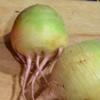 Ferment those radishes into delicious pickles!
Ferment those radishes into delicious pickles!
Do you like real cucumber pickles? Not the “quick pickles” made with a hot vinegar solution and canning, but the really yummy kind you get out of a barrel at the deli? Well those are made by fermentation, and I made a happy discovery last year that turnips, radishes and celery root ferment into the most delicious pickles too! They have a flavor all their own — a really tasty one.
In this example I used the watermelon radishes and celery root we’ve been getting in our shares, and got some turnips at the market. We do get turnips in our CSA shares periodically so remember this recipe when that happens because they are just the best when fermented into pickles! You can ferment any kind of radish too, by the way (regular red, French breakfast, Daikon) so keep that in mind for future boxes as well.
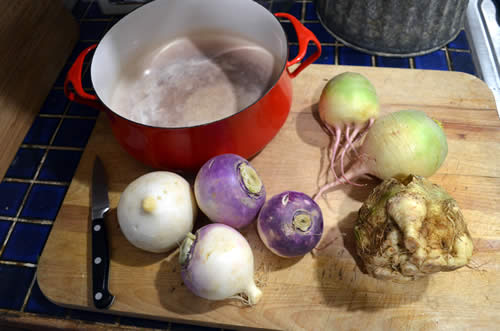
Scrub the turnips and radishes as needed, cut off tops and tails, and use a peeler on any iffy spots but otherwise you can leave the skin on if it is tender and clean. (Not so the celery root — ya have to cut off all the gnarly stuff).
See if you can find in your kitchen a bowl (or pot) and plate combo where the plate fits snugly inside the bowl; this will come in handy when brining (the first step) as it makes it easier to keep the veggies down in the brine (they want to float), but is not absolutely necessary. (Alternatively you could just brine them in a pot with a lid.)
Cut the turnips and radishes into wedges, and the celery root into pieces of roughly similar thickness and accumulate in aforementioned bowl/pot. Optionally, peel and toss in a few whole garlic cloves. (I didn’t add garlic in this example, but you’ll learn why a little further down.)
Make a brine (brine is just salt and water). For this type of ferment, I use a fairly salty brine: 1 tablespoon salt per cup of filtered water. Don’t use tap water – it has chlorine in it and will kill off the good bacteria you want to develop. In a similar vein, check your salt — avoid salt that has “anti-caking agents” in it (believe it or not, salt will actually have an “ingredient list”. Check it. It should only contain “salt” or “sea salt”). Stir it until the salt has completely dissolved into the water.
How much brine should you make up? However much you need in order to cover the veggies in the pot. I start with two cups, and if that’s not enough, I just make more.
So anyway, make brine and pour it over the cut up veggies until they are just covered. You’re going to soak them in the brine overnight.
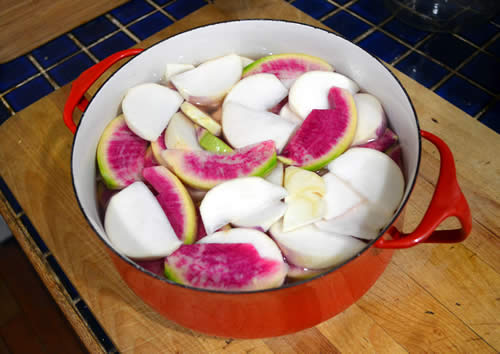
Here’s where the plate comes in handy — it helps to keep the veggies fully under the brine (they tend to float). Put the plate on top and add some weight. Mind you, this is not a critical step (like the actual fermentation stage where you do want to keep your veggies fully submerged). The veggies on the surface are still mostly surrounded by brine, so don’t sweat it if you don’t have a plate/pot combo. Just put a lid on the pot and it will be fine.
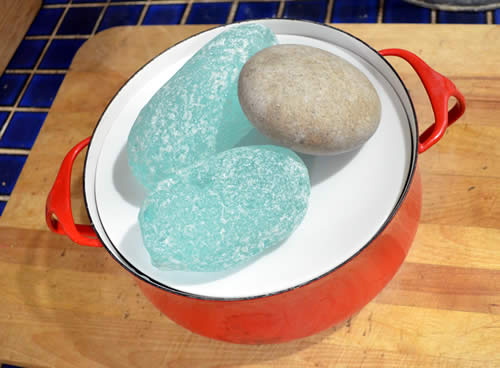
As the veggies soak, they will soften. Note how by morning the brine has come up over the top of the plate. Note, also, how it is turning pink from the pigment in the radishes! Cool, huh? By the time they’re done fermenting, the snow-white turnips will have absorbed the radishes’ pink hue, and the magenta radishes will have lost most of theirs to the brine such that they are hard to tell apart in the end! (See very last photo.)
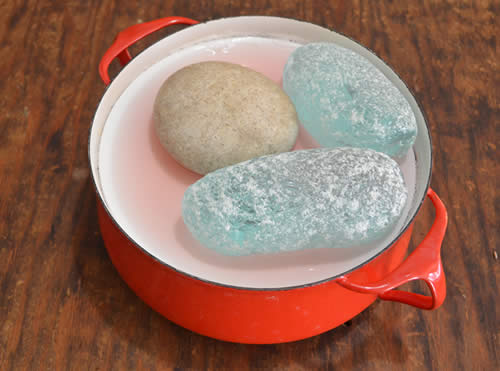
Next day sometime, gather your equipment: some wide-mouthed quart jars, and some skinnier jars that fit inside the jar mouth (for weighting the veggies down while they ferment).
Scoop the veggies out of the brine and start packing them into the jars. Remember, they’ve softened up so this is easier than you might think. (Harder in these pictures though, because I’m trying to do the packing with one hand while taking the pictures with the other!) Don’t pack the jars too full — leave yourself a good 2 inches of headroom so when the brine expands you don’t lose it all (more on this below).

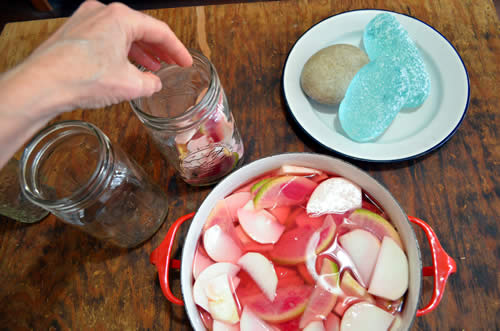
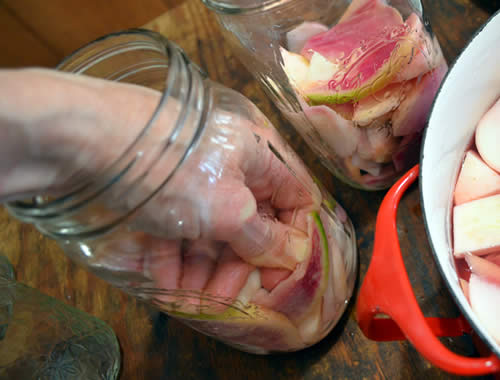
And don’t throw out that brine! Save it for future ferments! (again, more below.)
Save off a few of the larger wedges and lay them flat across the top of the veggies in the jar so that when the weighting jar is added, nothing pooches up alongside it (remember, the veggies still want to float, but during the fermenting process you want to keep them submerged).
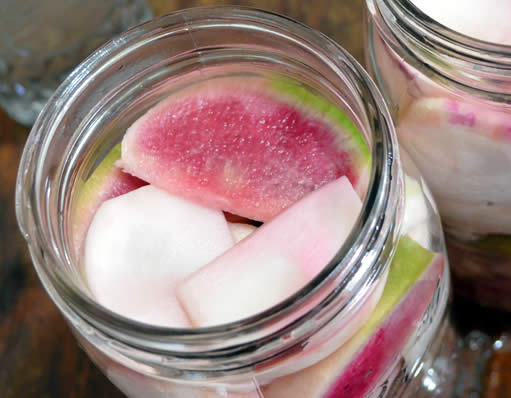
Next, fill your weighting jars with water and set on top of the veggies. Then using a turkey baster (or measuring cup — anything with a spout), add brine until it juuussst comes up to the top of the veggies. You don’t need to cover the veggies with an inch of brine (like they say in the books) because as the veggies ferment, the brine level will rise on its own and create the necessary “cover.”
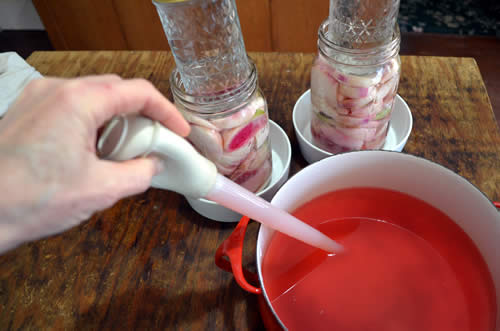
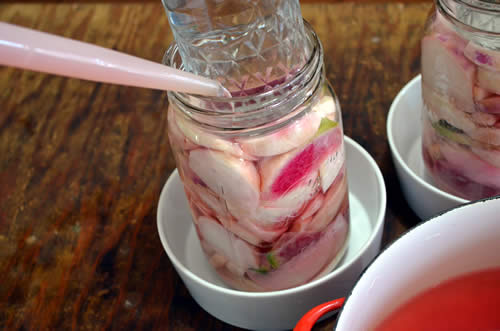
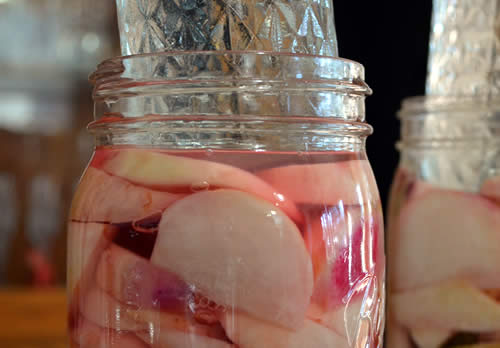
It’s always a good idea to place thusly prepared jars of veggies in some sort of bowl or dish, because like I say, that brine level WILL rise, so no matter how carefully you have planned for this, invariably it overflows some. Better to have a bowl to catch the overflow than wake up in the morning to a puddle!
Label your jars with the date you started the fermentation (i.e. the date you packed them into the jars, not the date you started brining them). If you have a good memory, you can skip this step, but I quickly forget — “was that Monday or Tuesday when I started them?”

Now leave the whole shebang out at room temperature and wait. I usually give it 5 – 7 days. Timing is not exact; if your kitchen is warm, or it’s summertime, you might only need to ferment them 4 or 5 days; if it is winter or your kitchen is not that warm, you can let it go 6 or 7 days. If you went 8 days it’s not like they’ll suddenly go “bad”, so don’t fret. In this example they were actually “done” in 3 days; I’ll explain why after I digress here to discuss left-over brine.
Regarding saving the left-over brine: you can strain it through a little cheesecloth to remove any oddball veggie particles and such, then put it into a jar, label it with the date and stick this in the back of your fridge. Next time you go to ferment some more veggies, pull it out and use it in the soaking step, supplementing with additional new brine as needed. What’s fun about this is that, over time, the brine develops complexity from the history of all the various veggies you’ve soaked in it and this is cool!
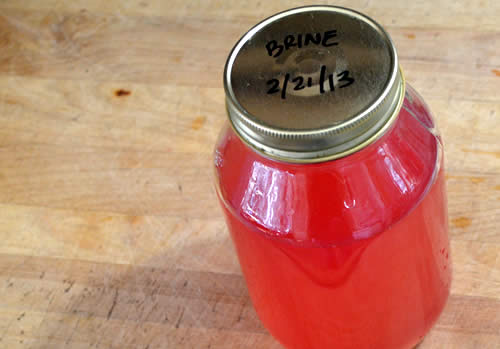
I actually pulled one jar of brine out of my fridge that was over 6 months old — I was going to toss it because it looked like a forgotten science experiment (wish I’d taken a picture for you): white scum on the surface, plus some unidentifiable lumpy stuff had settled into a murky layer down in the bottom; yeech. But when I opened it to dump out, I gave it a sniff and wow – it actually smelled wonderful!! So I thought, hmm. The brine between the scum and murk was crystal clear, so I carefully scooped as much of the scum off as I could with a paper towel, then using my turkey baster I gently siphoned the clear brine off into a separate jar, leaving the alien gook at the bottom undisturbed. Once the clear brine was safely removed, I examined the gunk more closely and realized it was just a bunch of garlic cloves and peppercorns I’d purposefully left in the brine from an earlier ferment (I’d just forgotten), and they’d simply started to break down. But the garlic was why the brine smelled so good!! They’d given their essence to it! I even took a sip, and it was deliciously sour/salty and garlick-y; I’m so glad I hadn’t thrown it out! So backtracking to that bit at the beginning where I say to strain used brine through cheesecloth — you don’t have to do that, but FYI stuff left in the brine will settle and deteriorate over time (as the above-mentioned garlic cloves did).
Oh, and by the way, when you’re done eating your pickled veggies, save that brine too — it’s the most flavorful of all! That’s what the “science experiment” brine was. Fermenting is a pretty forgiving process, as you can see!
Next day: note the rise in brine level. Note the bubble foam forming around the top.
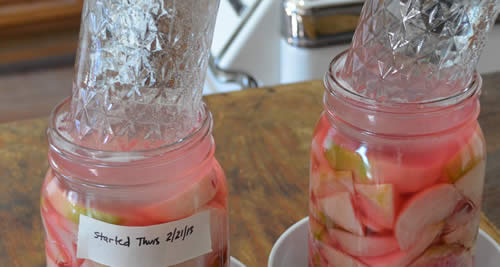
Day two: See what I mean about overflow? the brine has spilled over the edge (causing my label to keep falling off).
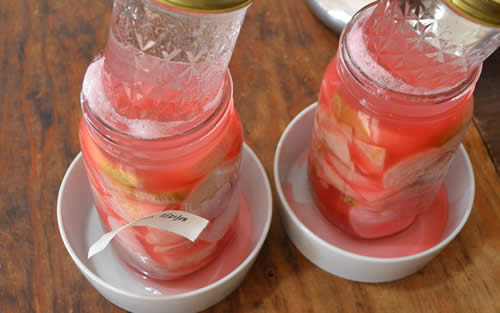
Part of figuring out how long to ferment your veggies is keeping an eye on how “active” it is. So swipe off the foam after 2-3 days with a finger or a piece of paper towel or something, then see if foam continues to form.
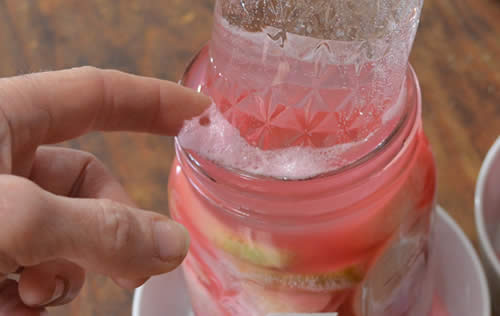
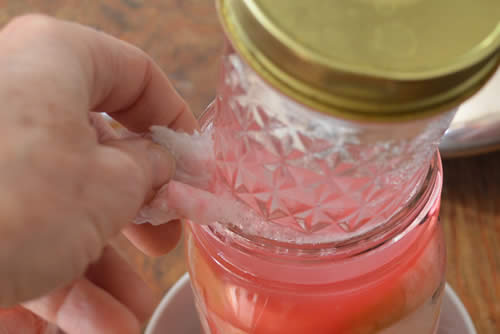
Look closely at the side of the jar too; notice little pockets of carbon-dioxide bubbles? Take a moment to simply observe — you will likely see bubbles actively rising up the side of the jar. It’s Alive! It’s so exciting!
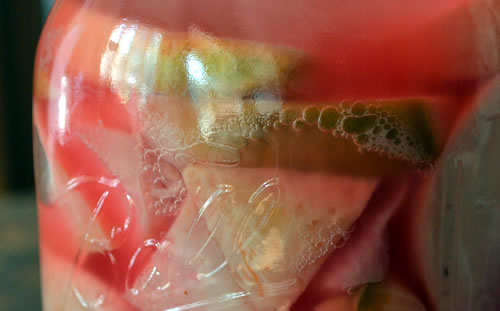
Of course the two most reliable ways to judge how your fermented veggies are coming along are Smell and Taste. Fermentation master Sandor Katz will tell you this. Use your senses. Is it starting to smell sour? Lift off the weighting jar, snag a piece of veg and taste it. Or stick your finger into the brine and taste it that way.
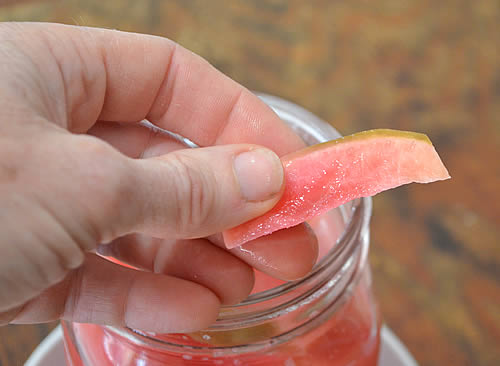
Does it still taste mostly salty? If yes, put the weighting jar back in and let it ferment longer. Check it again the next day. Does it taste sour and pickle-y yet? If so, remove the weighting jars, put a lid on the veggies and stick them in the fridge. They will continue to ferment slowly in the fridge, improving in flavor (so you can enjoy them over a month or three if you like — though mine never last that long ‘cuz I snack on ’em most every day).
A thing that will impact speed of fermentation is whether you started with fresh brine or used brine from prior ferments – as I did in this batch. Used brine — especially if it is what was left in the jar after you’ve eaten all the pickled veggies out of it (as opposed to brine that was only used to soak the veggies in the beginning step) — will have lots of active bacterial culture present (not unlike a sourdough starter) and consequently will jump-start your ferment. THAT’s why my ferment here took only 3 days.
If you don’t have used brine to work with like I did, don’t let this deter you! Lactobacillus is everywhere, in the air, on surfaces, etc, so when you start a batch of fermented veggies with fresh brine (i.e. saltwater you’ve just mixed up), the bacteria (which are salt tolerant) will do their job and ferment your veggies just fine — it may just take a little longer than if you use “used” brine, that’s all.
Oh, and one last thing – people always fret that the brine goes “cloudy.” Don’t fret — that’s perfectly normal. It has not gone “off” or “bad”; it’s simply the result of lactic acid bacteria doing their thing (lactobacilli convert lactose and other sugars from the vegetables into lactic acid, which is what gives your ferment that lovely sour taste, which is further flavored uniquely by the type of vegetables you’ve chosen to ferment).
Whatever you do, enjoy the process — and your pickles! (Hm… think I’ll go snack on some right now!)
 Lotsa Leeks!
Lotsa Leeks!
Got leeks piling up? Are they weighing on your conscience ‘cuz you’re not getting around to using them? Need a nuclear option? As Rebecca’s recipes will attest, there are plenty of ways to use them, but when you find yourself with a backlog, sometimes you have to take decisive action to reduce the population, as otherwise I’d swear they secretly reproduce overnight in the fridge.
[Oh, and by the way, I should’ve mentioned them as an ingredient in last week’s Parsnip soup — they could of course be used to excellent effect instead of (or in addition to!) the onion. Mea culpa for the omission!]
So the question is… what kind of recipes use lots of leeks yet don’t make you sick of them? One is the ol’ “crispy leeks” snack I wrote about a few years ago (you can use up quite a few that way!). But another sure-fire way to turn a large volume of leeks into a small, delectable quantity is… to caramelize them.
Whether you’re using leeks or onions, the caramelization process is more or less the same. And it is very much a slow food thing. You’re not browning them, you’re cooking them ever-so-slowly over the lowest possible flame in a good heavy-bottomed skillet (the thickness helps to diffuse the heat evenly so you don’t get burned spots). If you have a heat diffuser for your stove burner, all the better. Use it too.
This is what I mean by a heat diffuser. On my old ’50s O’Keefe & Merritt stove, the burner tops are swappable. At left below, I’ve moved the “diffuser” burner top to the front for use. The thickness of the diffuser combined with the thickness of the skillet makes for nice even heat. At right, it’s back where I usually keep it.
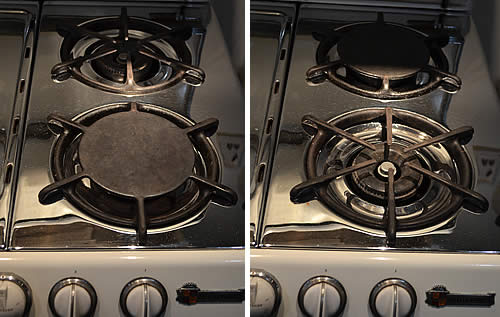
Once again, the process couldn’t be simpler. All it takes is patience. Slice up lots of onions or leeks as thinly as possible. I have a lovely little hand-slicer a friend gave me; makes paper-thin slices. But really, a good sharp knife will do the job too.
Melt about half a stick of butter and a generous few blorts of olive oil in a large heavy skillet over LOW heat. Add onions or leeks, stir to coat, then put a lid on, double-checking to make sure that heat is as low as you can get it… and wait. Check and stir every ten minutes or so.
After the first 10 minutes you’ll see they’ve started to sweat and give off a lot of liquid. This is good. give ’em a stir and return the lid. Check it again in 10 minutes; stir, cover, repeat.
After about half an hour, remove the lid and sprinkle in a little salt. You will notice the volume is starting to shrink. Leave the lid off and allow the juices to start to evaporate; keep stirring every 10 minutes or so, for an hour or more, until the onions are a uniform golden brown. (When they’re close to being done, keep a closer eye on them. They can go from caramelized to burned if you’re not careful.)
The caramelization process not only reduces the onions/leeks to a quarter or less of their original volume (excess leek problem solved!), it also renders them silky smooth, sweet and delicious! On top of that, it creates a heady kitchen aroma… hard not to drool!
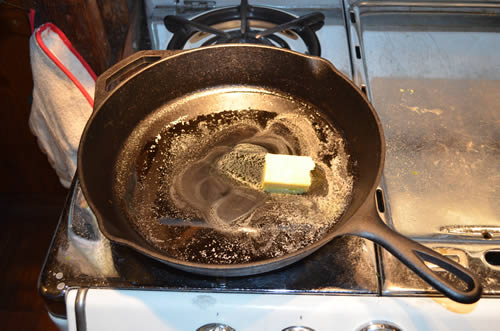
In these pictures I am indeed caramelizing onions, but the process is exactly the same for leeks. Note how dramatically the volume of onion reduces in this series of pictures! It really is astounding.
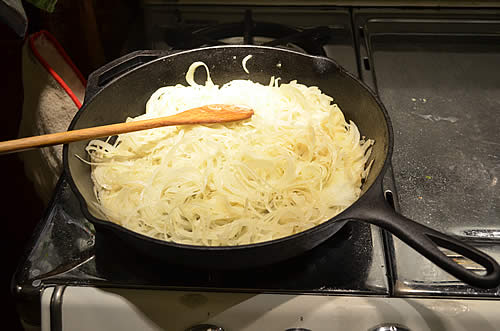

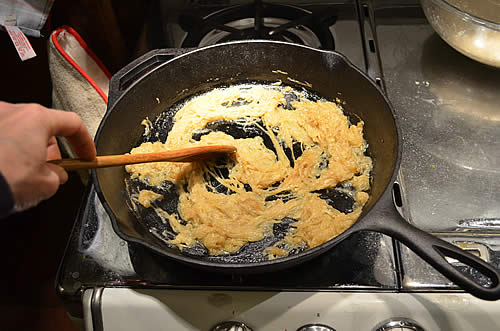
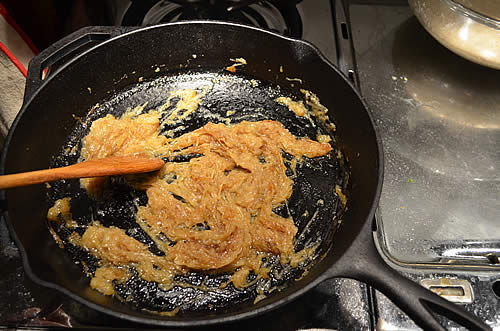
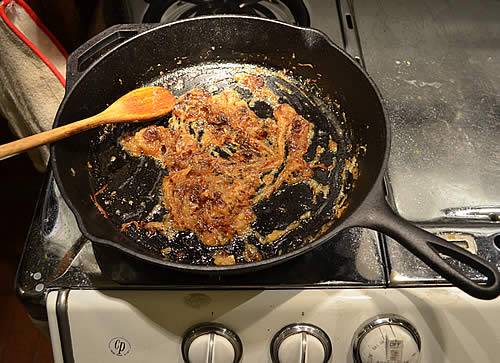
Now your next question is probably going to be, what do you do with those caramelized onions or leeks? Heck, so many things! Use them as a topping for anything from baked or mashed potatoes to sauteed greens, to grilled cheese sandwiches or steaks or chops if you’re a meat-eater; I like to use them on homemade pizza — my favorite? Caramelized onion (or leek!), anchovy and Kalamata olives. It’s almost like a foccacia, really. Anyway, that’s what I did here. If you just want to cook ’em up when you have some spare time, they’d freeze beautifully for later use, so don’t be afraid caramelize them just ‘cuz you don’t have a particular use for them yet.
If you want to make your own pizza dough and homemade pizza; here’s how I do it (recipe in my old database, from 2009).
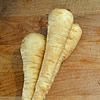 Parsnip Comfort Soup
Parsnip Comfort Soup
Okay, it’s true confessions time. I don’t like parsnips… well, at least, I thought I didn’t. Turns out I’m just not keen on their “parsnippy” flavor when they’re a-la-carte. We’ve started getting parsnips in the boxes again, and here I was on the verge of admitting defeat… but instead I decided to give them another shot. And wouldn’t you know it, I learned something new! My dislike was misdirected; I realized that they are great when mixed with other things, so that their flavor compliments instead of dominates. Who’d’a thunkit? It’s almost like a completely different vegetable! And what did I prepare that changed my mind? Soup. Simple, humble root soup.
I call it “Parsnip Comfort Soup”, because it is, well, just like it sounds. It’s not knock-your-socks-off-Wow! stuff; it is fall-apart comfort goodness like a cozy, warm blanket. Absolutely fabulous for this cold, grey, rainy weather we’re having. A steamy bowl of this is just so delicious; subtle, yet complex because the flavors of the different veggies you include imbue the stock with mellow richness.
And you know me, I’m all about simple, accessible cooking; stuff that’s easy for anyone to do – no fancy techniques or specialty ingredients involved. This is very forgiving.
In a nutshell, you heat stock of some sort*, add coarsely chunked up veggies plus some salt, peppercorns and chopped parsley, then cover and simmer it all for an hour or so… and that’s it! I’ve made this twice now, with different “supporting” veggies, and both versions just hit the spot.
*It’s always best with homemade stock, of course: vegetable, chicken, beef bones – I used chicken stock here (I always save carcasses and make my own/freeze it). This would probably also be lovely using just a ham hock and water as the “stock” — simmer the hock in several cups of water for a couple hours, until it’s falling apart; remove and dice up meat then add it back to pot along with veggies and cook that additional hour or so, ’til veggies are falling-apart soft.
What veggies?
parsnips
carrots
onion – red or yellow; doesn’t matter
celery
Optional (any or all)
fennel
potatoes
mushrooms
rutabaga
celery root (celeriac)
What seasonings?
just salt & pepper [I like whole peppercorns] and a goodly amount of chopped parsley
Also optional
meat — you could certainly add chunks of chicken if using a chicken stock, or chunks of beef if using beef… maybe even some sausage of some sort (I already mentioned ham hocks above, when discussing stock); but it is certainly not at all necessary. Again, it’s really forgiving.
Steps
Simply thaw/heat your frozen stock while you chop up your veggies. Peel and coarsely chunk up parsnips and celery root (if using – I used celery root this time, because I didn’t have any celery); toss ’em into the pot. The carrots are small right now, so just scrub them then nip off the tops and tails and maybe cut them in half. Chunk up anything else you’re adding… mushrooms, fennel, celery, whatever… add to pot. Chop up a bunch of parsley, add that. Toss in some peppercorns, add a little salt, bring just to a boil then turn down heat to the barest simmer, cover, and cook about an hour while you go do something else (make a salad, clean up the kitchen, help your kids with homework, whatever); the pot doesn’t have to be “babysat”.
Make yourself a pot of this soup, then serve it up with any green salad you like and maybe some good bread and butter (mmm, I’m thinking Companion Bakeshop’s fresh sourdough… you know, from the CSA’s bread option?) and you’ve got yourself a meal. The soup makes great left-overs for lunch, too, so don’t be afraid to make a big batch!
Here’s the ingredients for today’s batch.
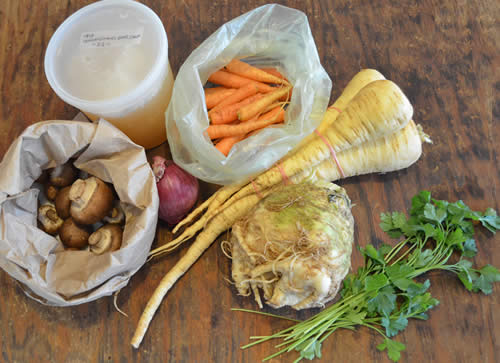
Start thawing/heating the stock while you chop veggies.
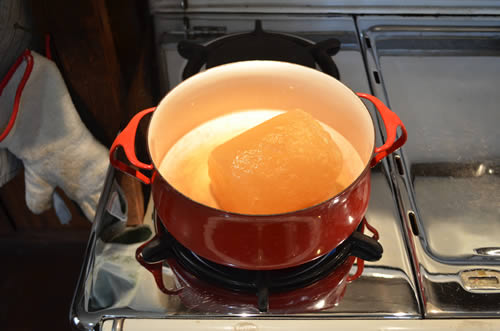
Peel the parsnips, cut out any funky spots (sometimes they get hit with the digging fork, as in this case), cut into big chunks (no need to dice).
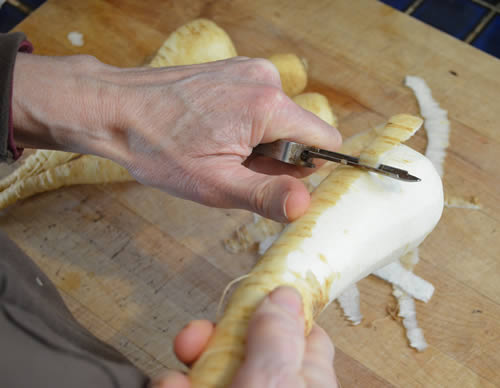
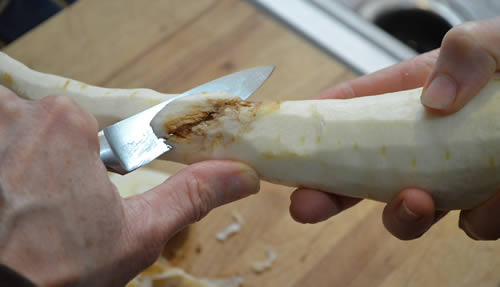
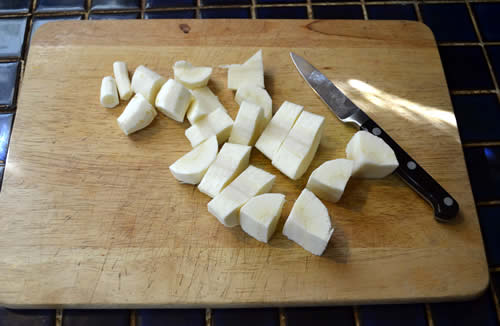
You can add the chopped veggies as you go; you don’t have to wait and add them all at once.
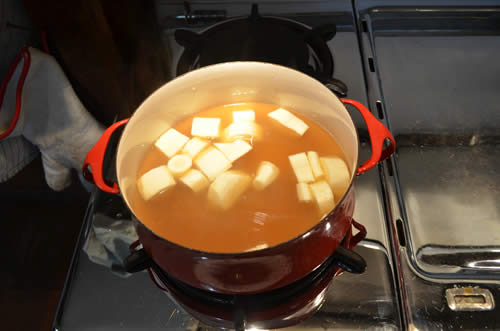
It’s not easy to peel a celery root with a peeler – I typically use a paring knife to cut away the outside down to its white interior, and work around its gnarly-root bottom.
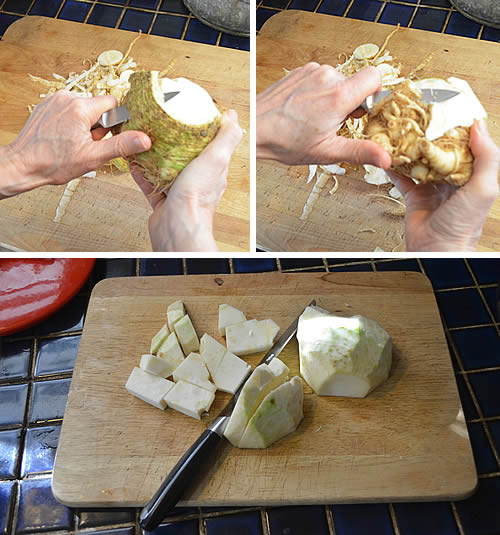
The carrots are small so just scrub them; no need to peel. (That smashed and distorted veggie scrub brush may look awful — it’s old, from the now defunct Fuller Brush Company — but it has nice stiff bristles and does the job; plus I haven’t been able to find a suitable replacement!)
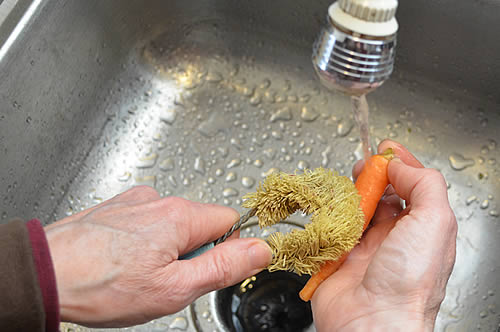
Here’s the pot with all the veggies freshly added… parsnips, celery root, carrot, red onion, mushrooms, parsley and peppercorns (they sunk to the bottom).
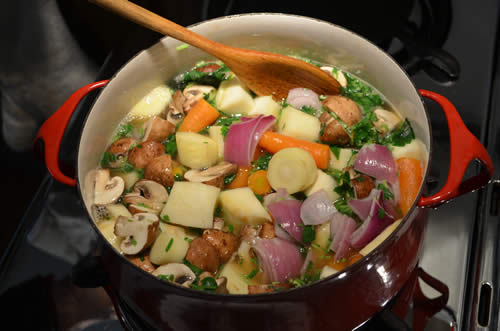
And here it is again an hour later. Notice how the parsnips are nice and soft.
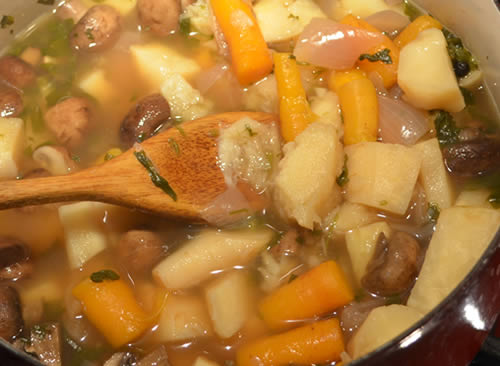
Lastly, this is the version I made the week before, with parsnips, carrots, celery, fennel, yellow onion (and the parsley, salt and peppercorns). Slightly different in flavor, with the fennel adding a nice dimension, but both were equally delicious!

Oh, and this photo has nothing to do with anything except I just had to share it with you guys ‘cuz it’s so fun! This is Belina, one of my chickens, “helping” me with the Sunday New York Times crossword puzzle (Faye and Audrey kibbitzing below) as I sit on my back steps and enjoy some sunshine.


